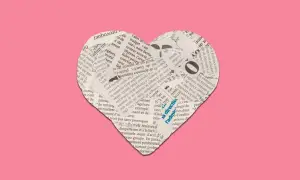At the Greater Good Science Center, we cover the science of a meaningful life. That means learning and writing about gratitude, relationships, joy, and awe—and reading other media and new research about those topics and more. As a result, I thought I had a comprehensive view of the other journalists, researchers, change agents, and media makers working in these areas.

But our new initiative on the science of love opened my eyes. We received a whopping 1,334 applications for grants about love, connection, and relationships, representing a huge diversity of media, formats, geographies, and communities. As director of the project, I personally read each application—quickly—and spent additional time on the projects that moved forward in the review process. In the end, it took 12 internal and 25 external reviewers working from March through June to evaluate the applications and select 23 winning applications.
Those individuals and media organizations will receive grants of between $5,000 and $50,000 each for projects on love. GGSC will also support them from September 2025 through March 2027 with guidance from scientific advisors and quarterly Zoom calls to facilitate shared learning among grantees and researchers. We’re planning two in-person convenings for the grantees, their advisors, and other scientists and journalists.
The process of reviewing and assessing these grant applications had a profound impact on me. I felt surprised and engaged by the hundreds of creative projects across the globe, led by dynamic nonfiction storytellers, all passionately dedicated to building a more loving society and shedding light on humanity’s capacity for love. I hope that by giving Greater Good readers a glimpse into how the process moved me, you might also benefit from inspiration and reassurance, at a time of great uncertainty with regard to technology, the political climate, economy, and more.
It pays to expand your media diet
As a journalist, I’m a voracious consumer of books, articles, podcasts, social videos, documentary film, and other nonfiction media. Yet many of the platforms and outlets that showed up in applications—either as applicants or as work samples—were new to me. I discovered new shows, series, and entire worlds of content that now comprise part of my routine media diet.
For example, I learned about 99.media, a platform for short-form documentary films that capture and evoke emotions in just a few minutes. I now regularly listen to the Pulse on WHYY and Proxy, to learn and reconsider the science of emotions (among other topics.) Who knew there were podcasts about Asian American pop culture history (Saturday School) and the intersections of music and science (Sing For Science).
I also discovered a slew of long-form journalists working in the same space that I do, whose newsletters and LinkedIn feeds help me stay abreast of new developments and engage me in their narratives. One of the best ways to grow as a writer is to read widely, and cast a wide net for inspiration—not only by topic but also narrative style and structure.
Love stories come in many forms and places
I felt surprised by the different communities, media, and angles that all saw themselves as fitting in the request for grant proposals we distributed. In some cases, this was wishful thinking—the program isn’t designed to fund the creation of a curriculum or board game—but other proposals merely reflected the diversity of love itself.
 Spreading Love Through the MediaThis piece is part of a three-year GGSC project to explore love’s role in promoting social well-being, bridging divides, and contributing to a good, meaningful life.
Spreading Love Through the MediaThis piece is part of a three-year GGSC project to explore love’s role in promoting social well-being, bridging divides, and contributing to a good, meaningful life.
The applicants included advocates for marginalized communities and recovery from a specific disease or natural disaster. Journalists covering immigration told poignant stories of separation, loss, and resilience. Visual storytellers shared moving projects about long-time lesbian partnerships and marriages affected by incarceration. Some applicants brought their most personal relationships into the grant proposal, describing emotional journeys and transformation over years or even decades. And many are independent media makers who already have attracted large and engaged audiences who are eager to learn about love and contribute to the conversation in the platforms—both public and private—on which grant applicants publish.
Romantic love was well-represented among the applications, as it is in research and popular media about love. However, I was impressed that the entire batch of applications included every one of the types of love we identified in our research summary, including love for humanity and across differences. Certainly, proposals on romantic and parental love featured heavily, but we also reviewed projects about loving strangers, love across distance, self-love, family relationships, friendships, and love across differences of identity.
More funding for storytelling will be well-spent
Awarding the grants felt bittersweet, in that the review team easily could have found another 23 or 46 grantees, or more, whose projects would enlighten, provoke, and move audiences. Assembling the grant cohort felt like putting together a college class, as we tried to select a diversity of media, experience levels, type of love, and narrative approach. As I wrote to those applicants who didn’t receive an award, I am rooting for them to find alternate funding and continue to pursue their projects. What the world needs now is love!
We didn’t want to part ways with the hundreds of creative, committed individuals who submitted exciting proposals. So, to capture that excitement, we’re hosting a Slack community for connection and collaboration among people who are working on media projects about love. As the grant cohort officially kicks off this month, we invite other interested media makers and journalists to join us in conversation and community. Email ggsclove@berkeley.edu to learn more.

